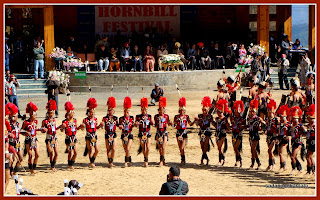 |
| Yimchunger tribal folk dance performance |
After
spending our first day in Kohima for a local sight-seeing, we were gearing up
for our real purpose of visiting Nagaland – watching live the much talked about
Hornbill Festival. This has been an annual feature since 2000 to show case the
cultural heritage of Nagaland’s 16 main tribes in particular and of seven
sister states of North-East in general. The
festival is held every year during December 1 to 7th where
all the major 16 tribes of Nagaland expose their folk dances, games, culinary expertises, religious ceremonies, handicrafts,
paintings, sculptures etc to the domestic and foreign tourists for whom
it is an opportunity to understand the culture and heritage of Naga tribes.
The festival
opens at 9.00 a.m. and closes at 4.00 p.m. The full schedule of the programmes of the Hornbill Festival is available in some prominent hotels as well as at the gate of the Kisama heritage village on the eve of the Festival. Based on the interest, tourists can decide as to which of the programmes they wish to attend and which can be skipped.
There are two ATMs belonging to State Bank of India and Axis Bank Ltd and a post office inside the Kisama heritage village which are in operations only during the Hornbill Festival week. The parcels of items purchased at the tribal handicraft, jewellery and painting exihibitions can be sent through this post office to whomsoever addressed in India. I am not sure whether this facility is available for foreign addresses.
Day-1 : Inaugural Function of Hornbill Festival
Kisama heritage village
which is located 12 kms from Kohima off Kohima-Imphal highway is the venue of the festival. The name ‘Kisama’ is
derived from two adjoining villages – Kigwema
(KI) village and Phesama (SA) village. MA in Nagamese language means village.
Although there are local buses plying between Kohima and Kisama and share taxi (Rs.50/-
per head for 7 seater and Rs.80/- per head for 4 seater), we engaged a full taxi
to drop us at the village (Rs.320/-) as being the first day, we wanted to be
there well before the start of the inauguration scheduled at 10.00 a.m. We
reached at the gate of Kisama village by 9.00 a.m. There was ample parking
space for buses and private cars. There was also a taxi stand close to the
gate.
After completing
the registration formalities at the gate, we were inside the festival venue. Since
we had 45 minutes of spare time before the inaugural function, we visited a few
of murungs ( a traditional Naga tribal houses for bachelors). Typically, each
murung was constructed with local woods and bamboos with thatched roofs made from dreid bamboo leaves. Experts
can distinguish from the style of construction of murung as to which tribe it
belonged. Moreover, each murung has its tribal flag hosted on the top of the roofs.
A man and a woman in their traditional dresses and jewelleries stood at the
door of the murungs. Each murung has enough space for its dancers to rehearse and
perform besides for a food stall for
the visitors to taste the food speciality of the respective tribe.
At around 9.30
a.m. dance performers and other artists in their tribal dress and jewelleries left
their respective murungs to the open
stadium and sat at the places earmarked for each of the 16 main Naga tribes. The
stadium was already being filled with both the domestic and foreign tourists. Both
professional and tourist photographers were permitted to move on the stadium
ground to take the pictures of tribal dance performers until the arrival of the
chief guests. Exactly at 10.00 a.m.,
both the Governor and the Chief Minister of Nagaland arrived and inaugural
function started. After the end of Governor’s short speech, the Festival was
inaugurated with a traditional blessing from a Naga tribal leader. This was
followed by glimpses of dances performed by each of the 16 Naga tribal groups.
The whole inaugural function was over in one hour. I would rate it as short and
sweet.
Thereafter both
the VIPs including the Governor and the Chief Ministers mingled with tourists
and joined them in visiting some of the murungs. Those who missed the glimpses of
the dances at the inaugural function could still watch those dances at the
respective tribe’s murungs. Some tasted the exotic non-vegetarian food
preparation of each tribe and watched some games inside the murungs. We tasted
the rice beers of two tribes in the bamboo mugs. We finished visiting all
murungs by 1.00 p.m. The weather was ideal for the event as despite sunny day,
it was pleasant to stroll inside the heritage village. The schedule for the
afternoon slot in the festival was the
full dance performance of all 16 Naga tribes, the glimpses of which we had already seen in the inaugural function.
Hence, we decided to return to our hotel for lunch and rest thereafter. As a part of the festival, there were some
night programmes like All-India Rock Music Festival, night bazaars etc. which
were held in the Kohima City itself. We decided to give them a miss.
Below are some
pictures taken during the first day of Hornbill Festival.
 |
| Entrance to Kisama Heritage Village (picture taken from inside the village) where Hornbill Festival is being held every year during the first week of December since 2000. |
 |
| A typical tribal Murung with flag of the tribe at the top. Bamboos and canes are used in the construction of Murung with thatched roof. In the front is the open space which is being utlised by the folk dancers for rehearsals. On the side is the space for visitors to sit and taste the respective tribal cuisine prepared in the kitchen, probably located at the backside of the Murung. |
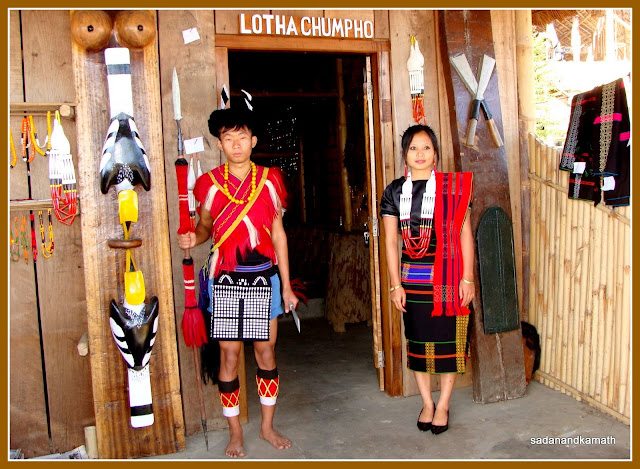 |
| Man and woman in their traditional Lotha tribal dress in front of their Morung. |
 |
| Folk dancers belonging to Sangtam tribe rehearsing the dance in front of their Morung |
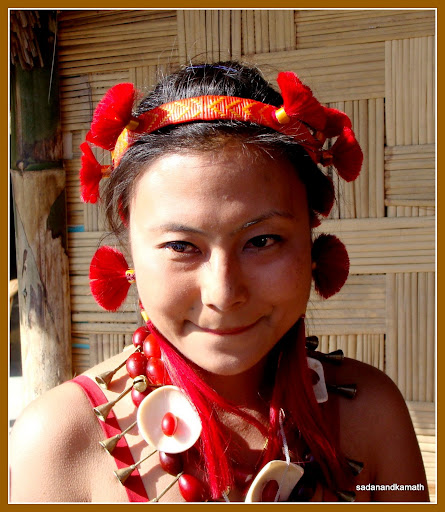 |
Sangtam belle
 |
Dance rehearsal of Konyak tribal folk dancers
 |
| Wood sculptures at the entrance to one of the Morungs. |
 |
| Wood sculpture of a lizard encircled by a python in one of the tribal murungs. |
 |
| Kachari man and women in front of their Morung. |
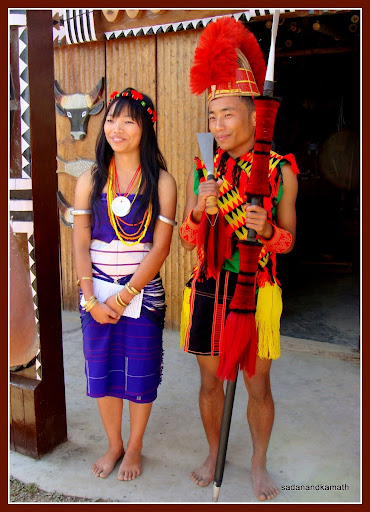 |
| Man and woman belonging to Pochury tribe in their tribal costume in front of their Morung. |
 |
| Sumi man and woman in front of their Morung |
 |
| Sangtam tribal costume |
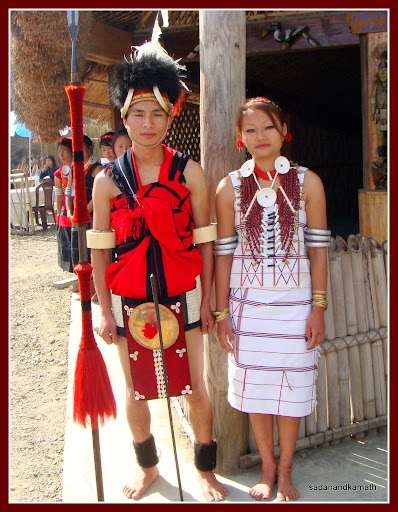 |
| Man and woman in Yimchunger tribal costume in front of their Morung. |
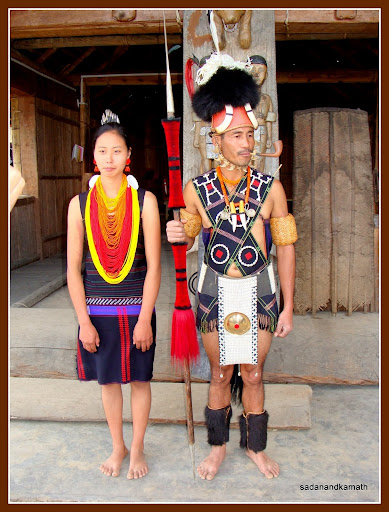 |
Man and woman in Khiamniugan tribal costumes in front of their Morung.

Man and woman belonging to Phom tribe.

Man and woman in Konyak tribal costumes in front of their Morung
 |
Konyak belle in her Jewelleries.
 |
| Folk dancers belonging to Phom tribe walking towards the stadium to take their allotted place. |
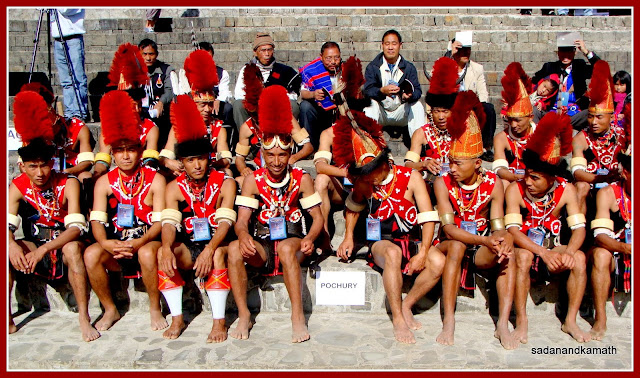 |
| Folk dancers belonging to Pochury tribe take their seats in the stadium. In all 16 main Naga tribals groups are allotted pre-determined seating places in the stadium in the front rows to facilitate easy access to the ground when their turns come for dance performance. |
 |
| Yimchunger tribal folk dancers take their seats in the stadium. |
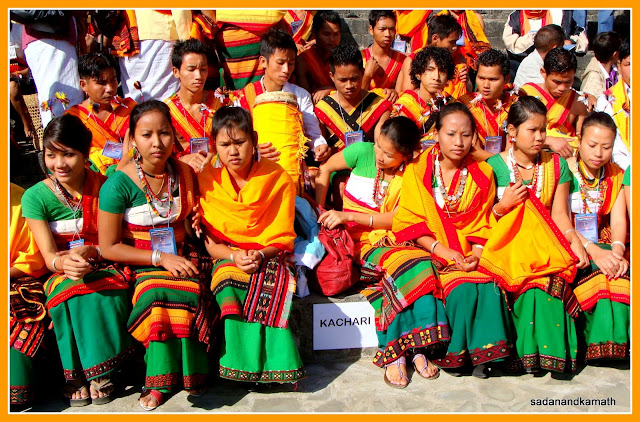 |
| Folk dancers belonging to Kachari tribe. |
 |
| Folk dancers belonging to Sangtam tribe. |
 |
| Folk dancers belonging to Khiamniungan. |
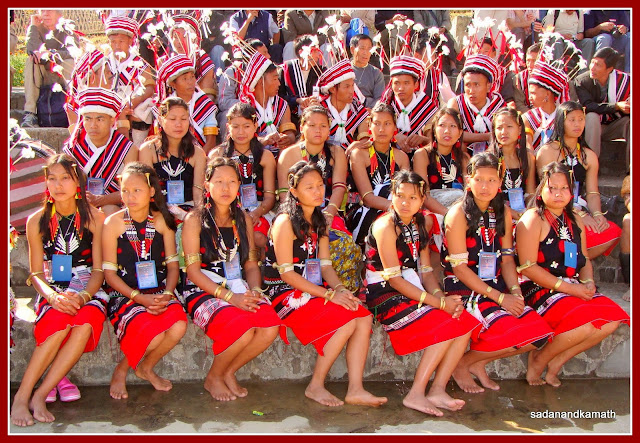 |
| Folk dancers from Zeliang Naga trribe. |
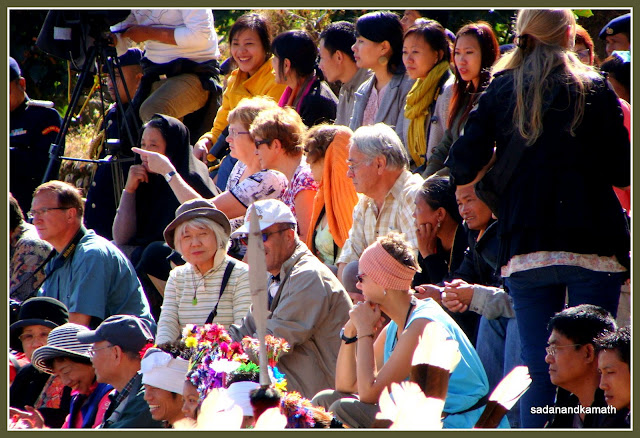 |
| Some of the foreign visitors in the stadium on the first day of Hornbill Festival. |
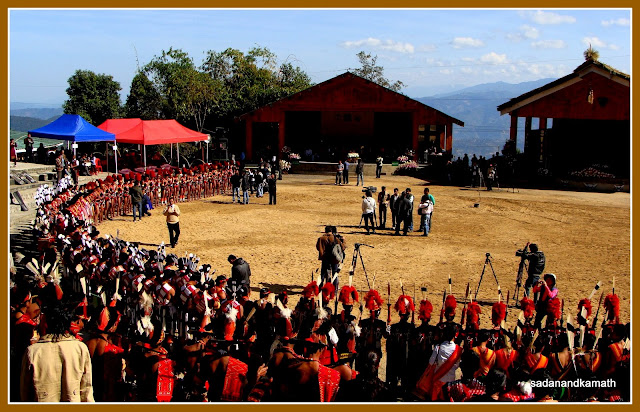 |
| All the tribal participants stand up as the arrival of Mr Nikhil Kumar, Governor of Nagaland is announced. The Inaugural function began as per schedule time of 10.00 a.m. The venue for the festival is very scenic surrounded by mountains and forest. |
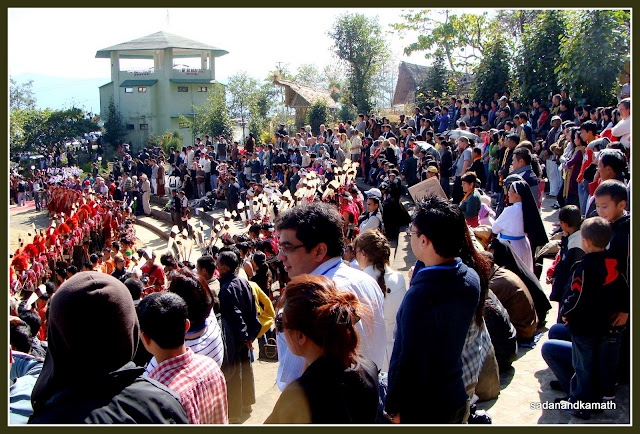 |
| Visitors and participants stand as National Anthem is being played. |
 |
| Nagaland Chief Minister Neiphiu Rio shakes hand with Governor Nikhil Kumar after his inaugural speech. |
 |
| As per the tradition, Tribal Guest Yansathung Jami (right with raised hand) pronounces traditional blessings for the Hornbill Festival. |
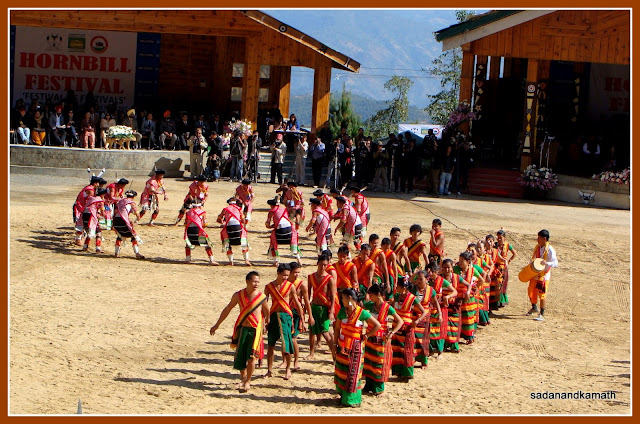 |
| The first group of tribal folk dancers on the ground. |
 |
| Yimchunger tribal folk dancers. |
 |
| Sangtam folk dancers. |
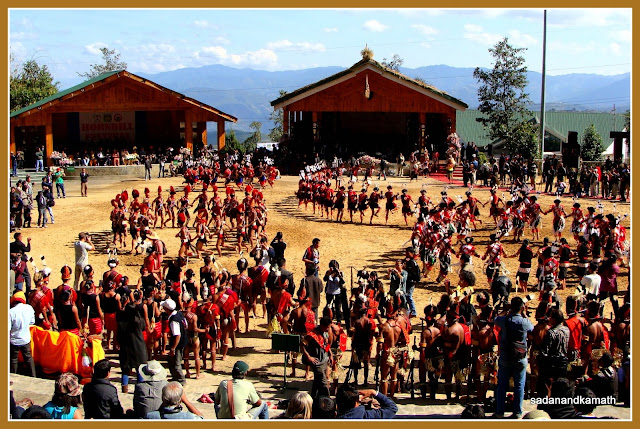 |
| Four group of tribal folk dancers dancing together during the inaugural function. In the background is VIP and VVIP rostrums. |
 |
| Folk dancers from Khiamnuiungan tribe rehearsing their dance for the afternoon performance. |
 |
| Two Angami belles getting ready for an interview with a T V Channel during lunch interlude. |
Day-2 : Dance Performances of Various Cultural
Groups of Other North-Eastern States.
The second day of
the Festival was earmarked for the dance performances by the various cultural
groups of other north-eastern states. After finishing the complimentary breakfast
at our hotel’s restaurant, we departed for Kisama to watch the dance
performances of other north-eastern states. In this programme, we saw tribal dance
performances of Meghalaya, Mizoram, Tripura, Arunachal Pradesh, Sikkim, Assam
and Manipur. The last one before the lunch break was a synchronised symphony
performed by Nagas, Bodos, Manipuris which received the standing ovation from the
spectators.
We had decided
that today we would have lunch in one of the Naga tribal murungs to taste the tribal
food. But we found that it was almost impossible to get the vegetarian lunch.
The non-vegetarian section had some of the exotic food items which many
non-vegetarians from other parts of India may not like to have them. Luckily
for us , we found at the far end of the heritage village a buffet food stall
run by Nagaland Women’s Welfare Association. They had arranged separate buffets
for vegetarian and non-vegetarian dishes. The cost of buffet lunch was Rs.300/-
per head. We took vegetarian lunch which consisted of fried rice, mixed dal, paneer-mattar,
boiled spinach salad, alu-flower and fruit custard. The buffet lunch was good. Later we found that
they also had a stall for tea/coffee, cold drinks and samosas at a very reasonable
price.
After lunch, we
came to witness other dances but soon noticed that they were the repetition of
the dances which we had seen in the
morning slot. I think the repetition of dance performances was for the benefit
of those tourists who missed the morning session. We left the stadium and
visited some tribal handicraft and jewellery exhibitions. After buying some handcrafts and jewellery items for my grand
children, we left the venue for our
hotel by taking a share sumo @Rs.50/- per head. During the journey, we noticed that not only
the big parking lot outside the gate was full of parked cars and buses, a large
number of cars were parked on the Imphal-Kohima highway and the tail of the
such parking cars was nearly two kms away from the venue.
Below are some
pictures taken during the second day of the Hornbill Festival.
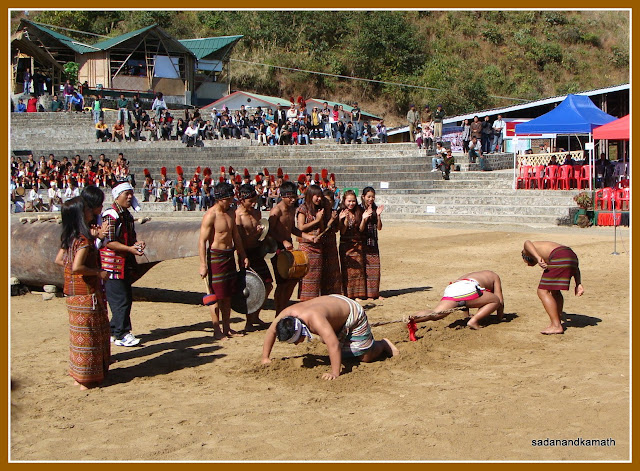 |
| A Mizo tribal sport competition is in progress. In this sport, one leg each of two participants' are tied with a single rope and the participants try to reach a marked line in front of them dragging the other participant. Participant who touches the marked line wins the competion. |
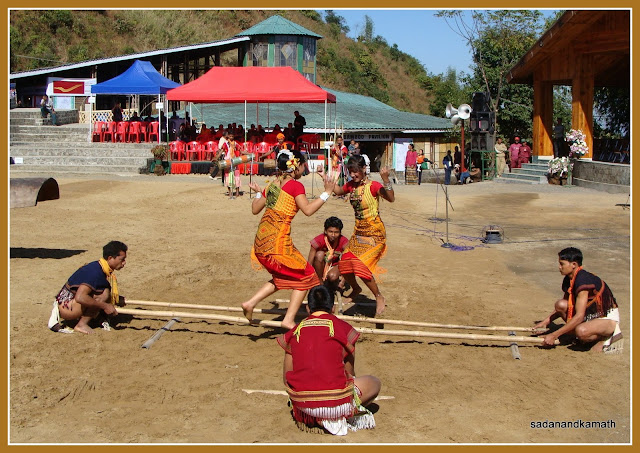 |
| Bamboo dance performed by the tribal dancers from Assam. |
 |
| Tribal dancers from Tripura waiting for their turn for dance performance |
 |
| Tribal dancers from Tripura performing balancing act during the dance performance. Standing at the far end is the singer and muscians. |
 |
Tribal dancers from Mizoram.
Folk dancers from Sikkim |
 |
Tribal dancers from Arunachal Pradesh.
 |
Arunachal Pradesh tribal belle
 |
Last minute adjustment of ear rings of a fellow tribal dancer from Meghalaya.
 |
Folk dancers from Meghalaya in action
 Tribal dancers from Mizoram performing bamboo dance.
Tribal dancers from Mizoram performing bamboo dance.
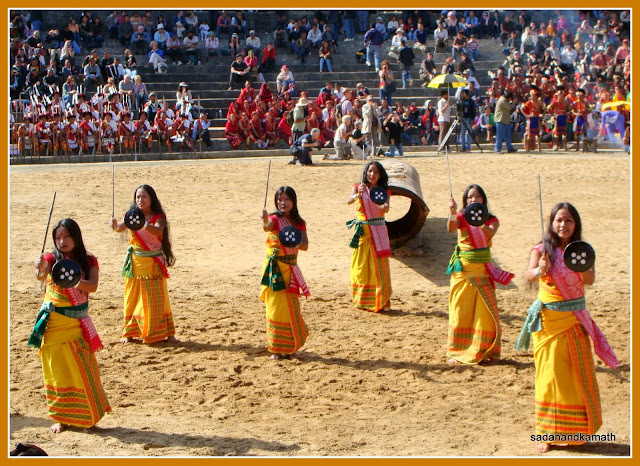 |
| Another group of folk dancers from Assam performing war dance. |
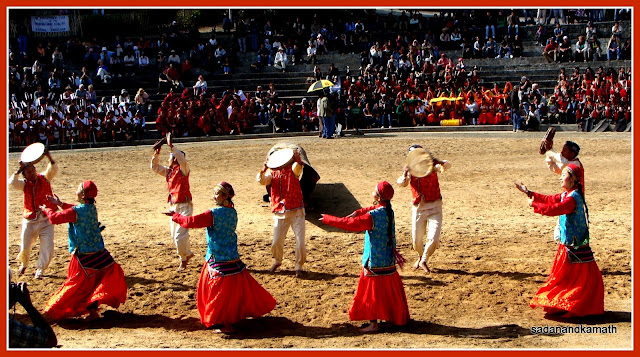 |
Another dance performance by folk dancers from Sikkim. This was, like the earlier one was also a foot stepping dance performed by this group with a melodious song and music.
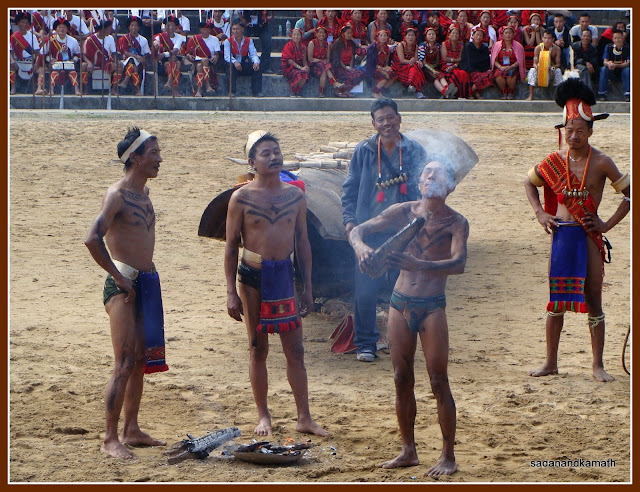 |
Fire eating display by a Konyak tribal man from Mon district of Nagaland. He ate red hot charcoal from a burning log.
 |
This Konyak Naga tribal brought this bench from the ground to the sideline holding the bench by his teeth.
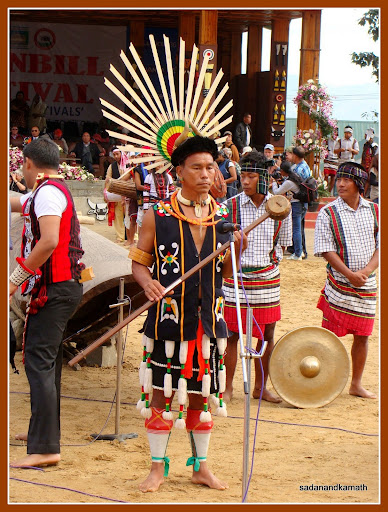
A Naga tribal about to start singing a song with his peculiar instrument as a part of fusion of drum music from 8 North-Eastern states.
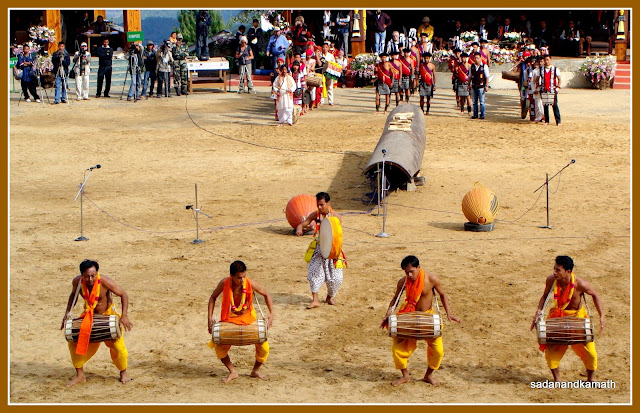 |
The first to start the fusion drum music from all North-Eastern states was dholak players from Manipur.
 |
This was the finale of traditional drum music from all North-Eastern states conducted by Naga music maestro Lipokmar Tzudir (back to the camera) who was also the composer of the music. The exhilarating performance of this North-Eastern Drum Ensemble kept the crowd mesmerised and the group received the standing ovation from a large crowd assembled at the venue.
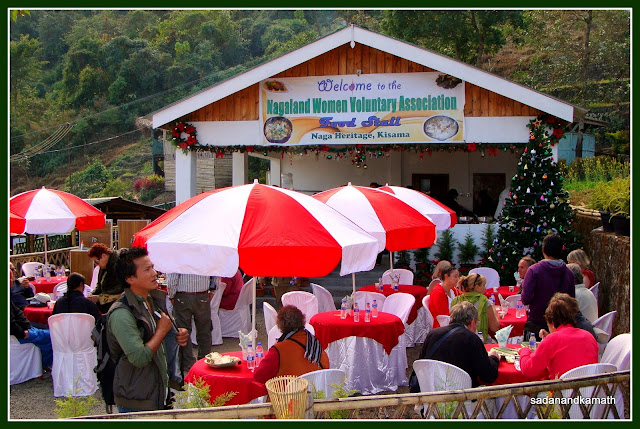 |
We took lunch at this stall where a varieties of options were available including vegetarian food.
Day-4 :
Naga Cultural Perforamnces – Art Gallery – World War – II Museum
We skipped 3rd
day of Hornbill Festival in favour of visiting Khonoma green village. My blog Khonoma
- A Historical Naga Village giving an account of our visit is separately posted.
We had planned for a day visit either to Dzouku Valley or to Tuophema village.
Since visit to Dzouku Valley required a trek of about 4-5 kms to reach the
valley, it was not possible to make it a day visit. Tuophema was a tourist
village. After getting a feel of the Naga culture and heritage at Hornbill
Festival and visting Khonoma village, we felt that we may not get to see
something interestingly different from what we had already seen at the festival.
So we dropped the idea of one of these visits and instead decided to spend one
more day at Hornbill Festival.
We reached
Kisama village by 10.00 a.m. As per the schedule of programme, the forenoon was
devoted to Naga Cultural Performances. We first decided to complete our visit
to Art Gallery which was located near the gate. The art gallery displayed
paintings of birds and day to day activities of Nagas by their tribal artists some
of whom were present in the gallery to do the live paintings. We spent about 30
minutes in the art gallery. We were impressed by the quality of their
paintings. Next, we visited World War II Museum which depicted the chronicles
of the Japanese attack on Kohima. The displays in the museum were impressive. A film on the important event
of World War II was being shown in a hall at some
fixed timings.
After completing
these visits, we proceeded towards stadium where the Naga Cultural performances
were in progress. These were mostly related to various Naga tribal songs and dances which are performed during various agricultural
activities. Being Sunday, the crowd at the Festival was the biggest so far. Between
12 noon and 1.00 p.m. chilli and pork eating competitions were slated to be
performed but we skipped them in favour of having a high tea ( with samosas) at
Nagaland Women’s Welfare Association’s stall. After a round of a
few murungs, we proceeded to towards the Bamboo Hall which was the venue of
Miss Nagaland Contest and fashion shows in the evening. The Bamboo Hall looked
elegant.
Just opposite
the Bamboo Hall, there was a restaurant which had a viewing gallery to watch the
valley and three villages on hill tops. We found that the restaurant was
serving mainly non-vegetarian food and momos. On our request, the manager of
the restaurant made vegetarian momos which took about 30 minutes to serve. That
was our lunch for the day. We returned to the hotel at about 2.00 p.m. by a
share taxi. We had not intended to see the remaining three days of the Hornbill
Festival as we had planned to take a train ride in the Barak Valley to Silchar and then to Agartala to spend a couple of days before starting the home journey .
Some of the pictures taken during the 4th day of Hornbill Festival are uploaded below :
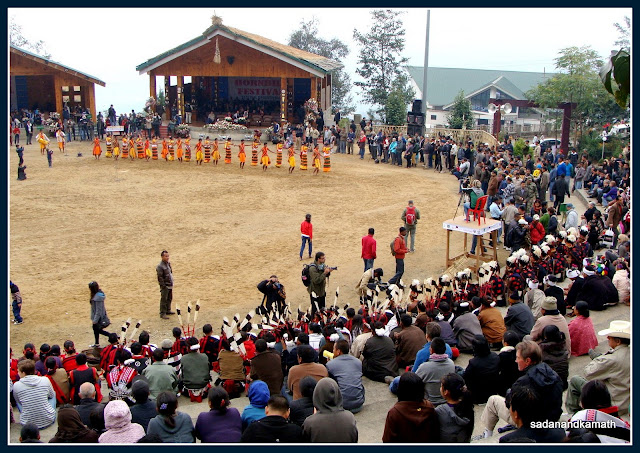 |
| Kachari group is performing the activity based dance on the fourth day. |
 |
Sangtam tribal women show the post-harvesting activities while the other Sangtam women sings the harvesting songs.
 |
The 'tribal chief' testing the suitability of one of his 'warriors' for head hunting by twisting his ear. If the participant shouts with pain, he is discarded from the head hunting team. Of course, the practice of head hunting ended some time at the beginning of 20th century.
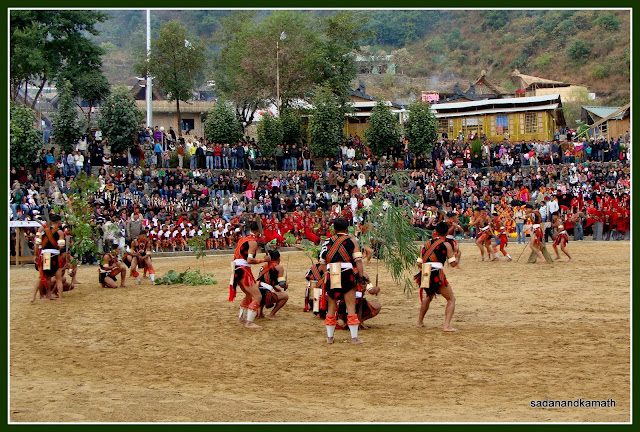 |
| After selection of warriors, the group is ready for a mock war with a neighbouring tribal hemlet. |
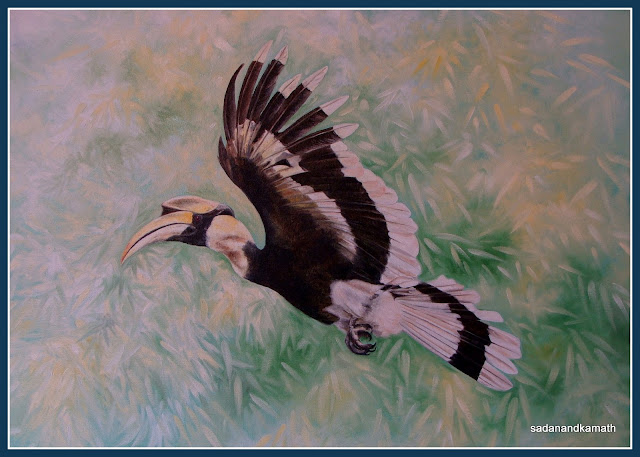 |
| One of the paintings of a Hornbill, the Nagaland State bird on display at the Art Gallery. |
 |
World War II Museum at the edge of Kisama Heritage Village. It is a very interesting museum depicting the sequence of Kohima War against the advancing Japanese forces. Photography inside the museum is prohibited.
 |
Kigwema village with its jhum ( terraced) fields seen from Kisama Heritage Village
 |
| The Bamboo Pavilion in Kisama heritage village where, children's painting and Naga fashion shows were conducted. |
10 comments:
Nice trip dude. Hey great post.. Real good information. and I haven't been there in India. After see pics i am so exicited to go there now. Surely Plan Your India Trip in this year for Hornbill Festival. Dont forget to take expert suggessions or reading India city guide HopAroundIndia regarding your trip before going to anywhere in India. Search and read particular city travel guide" to hop around india while visiting any place.
Every attractive travel destination has a story behind it, which adds more worth to its beauty...The same thing here makes Hornbill Festival first choice in Nagaland to see. Ur Blog is nice. Thanks for sharing. See more information about Destinations in India . Happy Hop Around India.............
According to you, is it better to attend hornbill festival on the inaugural day or all days are the same?
In my view, one should not miss the inaugural day of Hornbill festival. The atmosphere is great. One gets the opportunity to see the dance rehearsals of each of the 16 tribal dancers in front of their respective tribe's Murungs before the inaugural function starts. Also all the participants from 16 Naga tribes are present in the open stadium where the tourists are permitted to inter-act with them until the start of inaugural function which gives ample photo opportunity.
In about one hour of inaugural function, visitors get the glimpses of tribal dances of all 16 tribes, based on which one can decide as to which of the dance performances should not be missed on subsequent day/s.
Dear Mr. Kamath,
I'm contacting you on behalf of our studio, Design Stash. We have been asked by the Govt. of Nagaland to compile a guide book for this year's edition of the annual Hornbill Festival of Nagaland. I was wondering if you had any photographs of last year's Hornbill, which will help us a great deal in editing the guide this year. Images from Hornbill 2011 will also help.
I look forward to hearing from you soon, and I wish you the best in all your future endeavours.
Sincerely,
Mughaho Chishi mughaho@gmail.com
Design Stash Team stashdirect@gmail.com
Dimapur, Nagaland
I have sent a E-Mail to you.
Awesome pictures and coverage.
Regards from Nagaland
www.jimzubemophotos.blogspot.com
Dear Mr. Kamath,
Congratulations for such a wonderful collection of images from Hornbill Festival.
i would seek your permission to reproduce some of the images for a chapter in the forthcomin. thse pictures of embroidery and pattern over textile is exquisite and help to understand the Naga society.
2. I have been frantically searching for your contact email and when the same could not be traced, I am contacting through the public comment section.
kindly do send your consent at kniraj14@yahoo.com
We will be crediting the nine pictures to this blog alongwith your name.
With warm regards,
Niraj Kumar
Chief Editor,
Himalayan Bridges project
New Delhi
Post a Comment